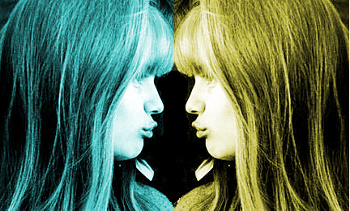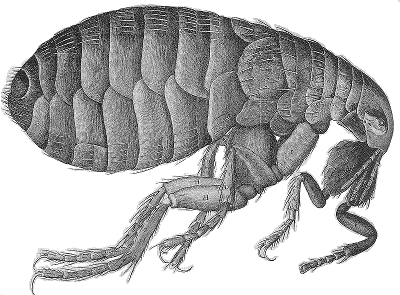Curiosity
March 26, 2015
The
Swedish film,
I Am Curious (Yellow),[1] was released in the US during my
college undergraduate days. In our
physics department, we renamed the film, "I Am Curious (580
nanometers)," where 580 nm is the
wavelength of
yellow light. This mildly
pornographic film, directed by
Vilgot Sjöman and
starring Lena Nyman, was a companion to the film,
I Am Curious (Blue). According to the opening
narrative of the yellow film, the blue film was too risqué for audiences outside Sweden, thus the yellow version.
Not that the yellow version didn't have its problems. It was
banned as being
obscene, until several US
courts overruled the ban. One tactic used by filmmakers is to insert content of "redeeming social value" into films like this as an argument against such bans. The film had an interview with
Martin Luther King, Jr., who was in
Stockholm during filming, and some
documentary about the
Russian poet,
Yevgeny Yevtushenko. The public had its own
curiosity about the film, since it was the twelfth most popular film screened in the US in
1969.

Blue and yellow versions.
Anna Lena Elisabet Nyman (1944 - 2011)
(Artistic rendering of a Wikimedia Commons image.)
Our perception of curiosity has changed over the short span of
human civilization. As
Philip Ball wrote in his 2013 book, "Curiosity,"[2] curiosity wasn't encouraged in early
history.
Eve and
Pandora were excoriated for their curiosity.
Augustine of Hippo (354 - 430) (a.k.a., Saint Augustine) wrote that curiosity was a
disease.[3] The
French mathematician,
Blaise Pascal (1623 - 1662), wrote in his
Pensées that "Curiosity is only vanity. We usually only want to know something so that we can talk about it."[3] The
proverb, "
curiosity killed the cat," dates from 1598.
At the time of the
Renaissance, curiosity started to become an admirable trait, and this change in attitude enabled the studies of
Galileo (1564 - 1642) and other
scientists of that time. The modern view of science is that we will always learn more by looking harder, but that attitude took a while to develop.
Still, the
English polymath,
Robert Hooke (1635 - 1703), who practiced science just after Galileo and demonstrated
Hooke's law, thought that
nature was
imprecise. As Ball writes, Hooke thought that nature didn't closely follow
mathematical laws.[4] Hooke's contemporary,
Isaac Newton, had the opposite conviction; and, just as Galileo, showed the
the unreasonable effectiveness of mathematics in the natural sciences.

No math required.
Robert Hooke collected micrographs of natural objects in his book, Micrographia (1665).
(Flea engraving from Micrographia, via (Wikimedia Commons))
Hooke also collected
drawings of his observations with a
optical microscope into a 1665 book,
Micrographia. Such a collection, requiring no mathematical description of objects, was a common expression of curiosity in the 17th century, when "
curiosity cabinets" were a polpular diversion. However, a scientist's focused curiosity was long in coming.
Einstein valued curiosity as a reason for his success in
science. In a 1952 letter, Einstein writes, "I have no special talents. I am only passionately curious."[5] Today, curiosity has become a valued
trait, and now there's even a
robotic rover named
Curiosity on
Mars.
What can be more
self-referential than scientists studying curiosity? They've found that curiosity peaks depending on the
information we have on a topic. We're most curious when we have a little information, but not enough information to quench our desire to learn more. The feeling of curiosity is the result of a gap between what's known, and what we want to know.[6]
Qiong Wu of
Nanyang Technological University (Singapore) published an article on
computational curiosity in 2013 in the
ACM journal,
ACM Computing Surveys,[7] and she has posted a draft of a book, "Computational Curiosity," on
arXiv.[8] Computational curiosity involves both
modeling of curiosity and the use of curiosity as an
agent for such
computer applications as
recommender systems. In the book draft, Wu gives examples of some of the
theories about curiosity. In one such theory, curiosity is seen as a means to mitigate
fear. Fear is associated with unfamiliarity, and curiosity motivates exploration that renders the
environment familiar.[8]
As most of us know from experience on large
retail websites, such as
Amazon, recommender systems are a welcome technique to enhance our online experience. Many interesting items are discovered through such referrals, but these systems might be enhanced by a curiosity-driven
algorithm. An example given by Wu is to recommend that oddball item purchased by another who has a purchasing history similar to my own.
I'll end this article with a few
quotations by scientists about curiosity, as harvested from the
Good Reads web site.[3]
"Study hard what interests you the most in the most undisciplined, irreverent and original manner possible." (Richard Feynman)
“Satisfaction of one's curiosity is one of the greatest sources of happiness in life." (Linus Pauling)
"No one asks how to motivate a baby. A baby naturally explores everything it can get at, unless restraining forces have already been at work. And this tendency doesn't die out, it's wiped out." (B. F. Skinner)
"Real scientists do not take vacations. They take field trips..." (E. O. Wilson)
"Science is not an intelligence test. Intuition is important, knowing what kind of questions to ask. The other thing is a passion for getting to the core of the problem." (Torsten Wiesel)
The
climate change controversy is just a recent chapter in the
assault on science. In 2001, Torsten Wiesel, who was awarded the 1981
Nobel Prize in Physiology or Medicine, was
nominated to an advisory panel of the
National Institutes of Health. The
Secretary of Health and Human Services at that time rejected Wiesel's nomination, the supposed reason being that Wiesel had signed too many full-page letters in
The New York Times that were critical of then
president,
George W. Bush.
References:
- I Am Curious (Yellow) (1969, Vilgot Sjöman, Director), on the Internet Movie Database.
- Philip Ball, "Curiosity - How Science Became Interested in Everything," University of Chicago Press (April 3, 2013), 480 pages. Available from Amazon.
- Quotes About Curiosity, Good Reads Web Site.
- Peter Forbes, "Curiosity: How Science Became Interested in Everything by Philip Ball," The Guardian (UK), June 8, 2012.
- Albert Einstein, Letter to Carl Seelig (March 11, 1952), Einstein Archives 39-013, via Wikiquote.
- Jonah Lehrer, "The Itch of Curiosity," Wired August 3, 2010.
- Qiong Wu, "Curiosity: From psychology to computation," ACM Computing Surveys, vol. 46, no. 2 (November, 2013), Article No. 18, doi:10.1145/2543581.2543585.
- Qiong Wu, "Computational Curiosity (A Book Draft)," arXiv, Feb 17, 2015.
Permanent Link to this article
Linked Keywords: Swedish; film; I Am Curious (Yellow); college undergraduate; physics; nanometer; wavelength; yellow; light; pornography; pornographic; Vilgot Sjöman; star; Lena Nyman; I Am Curious (Blue); narrative; ban; obscenity; obscene; court; Martin Luther King, Jr.; Stockholm; documentary film; Russian; poet; Yevgeny Yevtushenko; curiosity; 1969; Anna Lena Elisabet Nyman (1944 - 2011); Wikimedia Commons; human; civilization; Philip Ball; history; Eve; Pandora; Augustine of Hippo (354 - 430); disease; France; French; mathematician; Blaise Pascal (1623 - 1662); Pensées; proverbial phrase; proverb; curiosity killed the cat; Renaissance; Galileo Galilei (1564 - 1642); scientist; English; polymath; Robert Hooke; Hooke's law; nature; imprecise; mathematical; physical law; Isaac Newton; the unreasonable effectiveness of mathematics in the natural sciences; Micrographia; flea; drawing; optical microscope; 17th century; curiosity cabinet; Albert Einstein; science; trait; robot; robotic; space exploration rover Curiosity; Mars; self-reference; self-referential; information; Nanyang Technological University (Singapore); scientific literature; publish; computation; computational; Association for Computing Machinery; ACM; ACM Computing Surveys; arXiv; computer simulation; modeling; intelligent agent; application software; computer application; recommender system; theory; theories; fear; environment; retail; website; Amazon; algorithm; quotation; Good Reads; Richard Feynman; Linus Pauling; infant; baby; B. F. Skinner; holiday; vacation; field trip; E. O. Wilson; Stanford-Binet intelligence scales; intelligence test; intuition; Torsten Wiesel; global warming controversy; climate change controversy; antiscience; assault on science; Nobel Prize in Physiology or Medicine; nomination; nominate; National Institutes of Health; Secretary of Health and Human Services; The New York Times; President of the United States; George W. Bush; I Am Curious (Yellow) (1969, Vilgot Sjöman, Director).